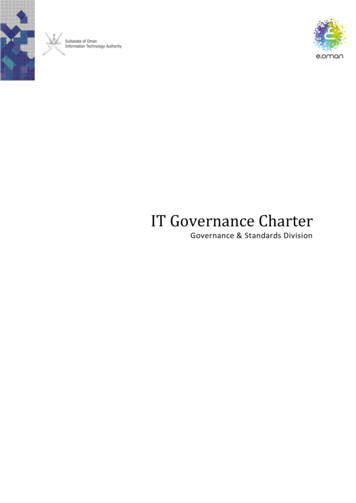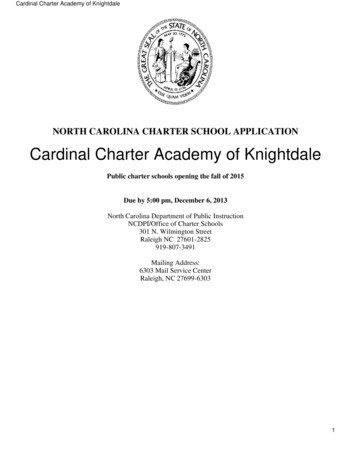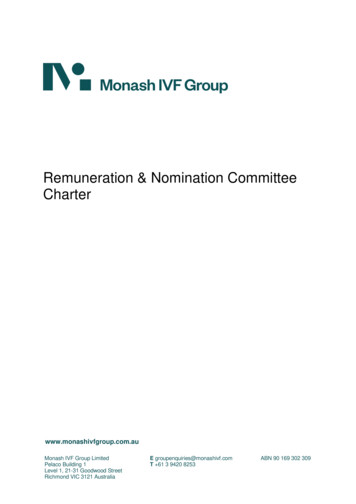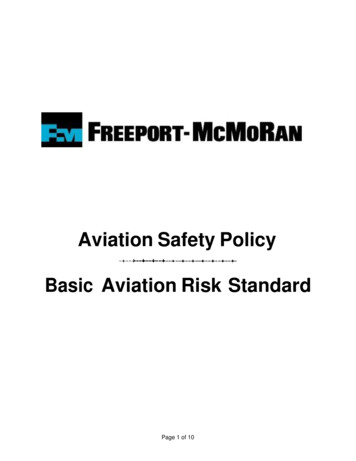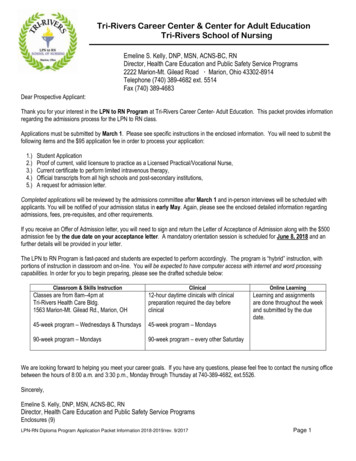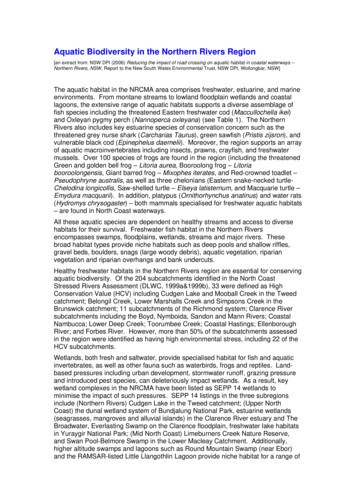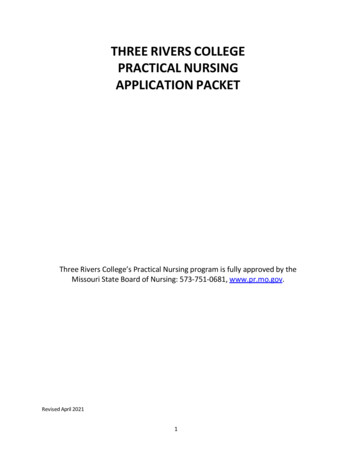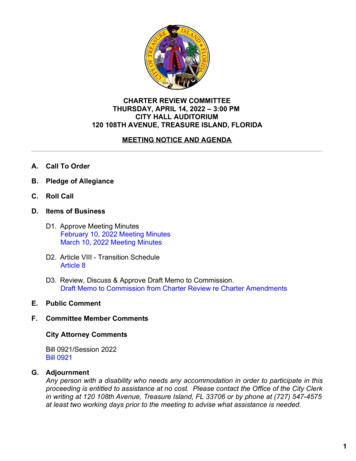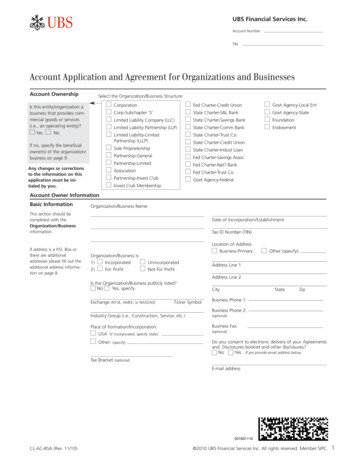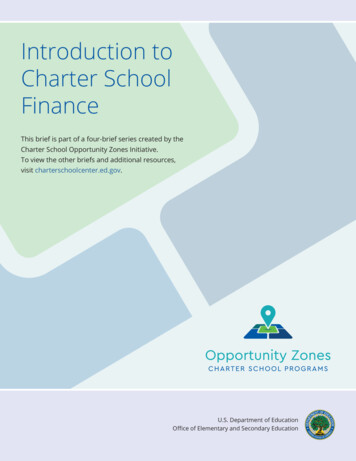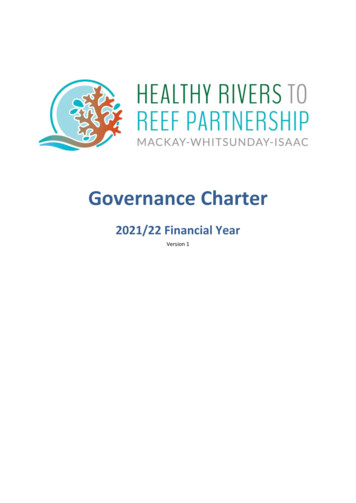
Transcription
Governance Charter2021/22 Financial YearVersion 1
Table of ContentsGovernance Charteri2021/22 Financial YeariPurpose of this document1Purpose of the Partnership1Objectives of the Partnership2Governance responsibilities2Technical Working Group responsibilities5Independent Science Panel5Host Organisation6Operational Guidelines6Attachment A Nested Program Approach10Attachment B Partnership, Management Committee and TWG members11Attachment C Partnership Memorandum of Understanding13Attachment D Partnership Terms of Reference18Attachment E Management Committee Terms of Reference24Attachment F Technical Working Group Terms of Reference26Attachment G Hosting Agreement26Role of the Host and Operational Requirements27Host KPIs31Attachment H Chair’s KPIs and Remuneration Protocol33Attachment I HR2RP declaration of interest register (example)37Attachment J Data sharing guidelines for the Healthy Rivers to Reef Partnership411
Purpose of this documentThe Mackay-Whitsunday-Isaac Healthy Rivers to Reef Partnership (the Partnership)governance charter outlines the purpose, objectives, key personnel and committees, theiroperational responsibilities and input of regional working groups. It also containsoperational guidelines for the Partnership and host organisation and the Memorandum ofUnderstanding (MoU) for Partnership membership.It includes a consolidated set of agreements developed and agreed by the Partnership sinceits inception in October 2014. It aims to ensure that all partners have a commonunderstanding of the Partnership's governance and operation.This Charter will be reviewed annually to ensure the membership and governance andprocesses are current.Purpose of the PartnershipThe primary purpose of the Partnership is to develop an annual Mackay-Whitsunday-Isaacregional waterway health report card. The report card uses the best independent scienceand integrates a range of GBR- wide and regional monitoring programs to measurewaterway health in an environmental, social, economic and cultural context. By drawing oninformation from existing monitoring programs, duplications and gaps can be identified, andmore easily communicated information provided to the community in a cost-effective way.For the purpose of this Partnership, the reporting region includes five regional basins (theDon, Proserpine, Pioneer, O’Connell and Plane), urban areas, the ports of Abbot Point,Mackay and Hay Point, marinas and the adjacent coastal and marine area to the easternboundary of the Great Barrier Reef Marine Park.A range of reporting products is produced for the Great Barrier Reef that complement eachother and respond to different drivers (see Attachment A). The intent is to have a Reef-wideapproach to reporting, with nested regional products that provide finer scale information.The regional program will collect similar core indicators that can then be rolled up into Reefwide or state-wide reporting and will deliver products at a scale that communities can relateto.Refer to the Partnership’s Program Plan for further detail on the Partnership’s objectives andstrategic focus.1
Objectives of the PartnershipThe members are committed to delivering the following objectives through the MackayWhitsunday-Isaac Healthy Rivers to Reef Partnership: Communicate information effectively and at a relevant scale to the broader community onwaterway health issues with scientific integrity, independence and transparency.Be specific to the Mackay-Whitsunday-Isaac region and consistent with other regionalwaterway report cards, including the Wet Tropics, Townsville Dry Tropics, Gladstone andFitzroy.Provide effective, coordinated, strategic and transparent investment to ensure cost effectivedevelopment of an annual report card.Consolidate and integrate outputs from ambient and event monitoring programs as well asdifferent modelling platforms.Provide scientific information that may assist in improving or maintaining theenvironmental, social and economic values of our Region.Inform planning and delivery activities of the Partners in response to the findings of thereport card.Utilise the stewardship assessments in the report cards to promote Partners’ activities whiledrawing on the report card's findings to identify enhanced or additional managementactions.Communicate our understanding of catchment-wide cumulative impacts.Foster a culture of collaboration between Partners for the benefit of our Region’s waterwaysand communities.Develop community education initiatives.Act as advocates for priority regional outcomes in line with the Partnership’s objectives.Role of the Partnership in responding to regional issuesThe Partnership has a role to facilitate responses from individual Partners in response toregional issues (for example, natural disasters, pollution events etc.). It is not thePartnership’s role (via the Chair, deputy-Chair or staff) to provide public comment onregional issues of concern that have or have the potential to impact on waterway health orcommunity wellbeing. Individual Partners may wish to provide a public response to aregional issue of concern, particularly where there is an action associated with improvingwaterway health or community wellbeing associated with the response.Governance responsibilitiesChairThe Chair will have responsibility for chairing both the Partnership and ManagementCommittee. The Chair is appointed for a fixed term (currently two years, 20/21 FY and 21/22FY) with the tenure to be decided by the Partnership and Management Committee. Tenureis subject to an annual review (due at the start of the 21/22 FY). The Chair is selected by an2
Expression of Interest process that the Management Committee leads. The process forselecting the Chair is to begin six months prior to the end of the current Chair’s contract.The selection process and the role of Chair is further detailed in the Terms of Reference forboth the Partnership and the Management Committee. The position is evaluated againstKey Performance Indicators (KPI). Chair KPIs for the 20/22 FY are included in Attachment HChair’s KPIs and Remuneration Protocol, along with measures to evaluate performance andthe position’s remuneration protocol.Deputy ChairThe Deputy Chair of the Partnership is elected by the Partners. The selected Deputy Chairwill be responsible for chairing both the Partnership and Management Committee in theabsence of the Chair. The Deputy Chair will only be remunerated when standing in for theChair.The tenure of the Deputy Chair is two years (20/21 - 21/22 FYs), unless otherwise specifiedby the Management Committee or Partnership.Executive OfficerThe role of the Executive Officer is to successfully deliver secretariat functions and manageall operational arrangements for the Partnership.The Executive Officer will be employed by the host organisation on behalf of the Partnershipand will: Coordinate the implementation of projects, all reports and any contracted worksassociated with the Partnership, including communications, governance andtechnical support. Coordinate the delivery of secretariat and operational functions of the Partnership. Work with partners to finalise the development of the regional waterway healthReport Card. Maintain and enhance governance arrangements for the Partnership via stakeholderengagement activities with current and prospective Partners, via promotion of thePartnership’s profile and reputation. Maintain, develop and seek new networks and relationships with members(including new members), stakeholders and the community. Oversee the management of the Partnership’s budget, including performancereporting and audits, as well as promoting financial membership for the next year tocurrent and prospective partners. Work closely with the Communications Team at Reef Catchments (if utilised todeliver on the Partnership’s communications and engagement strategy) to develop acommunication and engagement strategy for all Project phases as well as monitorand update all publicly available information on the Partnership and its deliverables(e.g. via the website and media releases). Provide Project support for the secretariat and operational functions of thePartnership, including organisation of meetings/functions, providing/circulatingdeliverables. Provide direction, support and assistance to the Technical Officer/s (and any otherstaff) as required.3
Technical OfficersThe Technical Officers will coordinate all technical activities of the Partnership, the primaryoutput being the annual Report Card for the region.The Technical Officers will be employed by the host organisation on behalf on thePartnership and will: Develop, collate, synthesise and disseminate technical and scientific information thatcontributes to the annual Report Card.Develop and regularly review and update the program design and associatedreporting to deliver the annual Report Card based on a range of data andinformation.Work closely with the Partnership’s Technical Working Group and the Reef PlanIndependent Science Panel to ensure the scientific validity of the reportingframework.Coordinate and implement a data management system on behalf of the Partnership.Communicate the program and its outcomes to technical and non- technicalaudiences, as per the Partnership’s communications and engagement strategy.Work closely with the Executive Officer to develop relevant and tailoredcommunication products on behalf of the Partnership.Work closely with the Partnership’s chosen communication resources and externalservice providers to develop and maintain the Partnership’s website.Assist the Executive Officer to develop scopes of work and contracts for externalservice providers on behalf of the Partnership, where required.Assist the Executive Officer with developing agendas and taking minutes forPartnership, Management Committee and other meetings as required.Communicate technical budget information to the Executive Officer for the purposeof financial reporting back to the Management Committee and/or Partnership.Other functions as required.Other HR2RP staffThe Partnership may employ additional staff to support the priorities and functions of thePartnership. The Management Committee, HR2RP staff and Chair will review the need foradditional resources on a regular basis. As per the financial delegations listed on page 7, thePartnership will be responsible for endorsing the appointment of staff resulting in 10%changes to endorsed annual budgets.PartnershipOne of the key objectives of any partnership model is to ensure commitment andparticipation from all members. Partners meet two-three times a year to provide strategicdirection and oversight of the work of the Management Committee and the host. The fulllist of Partners is in Attachment B.Commitment to the Partnership is through a Memorandum of Understanding (MOU) signedby all partners (Attachment C).The Partnership Terms of Reference is in Attachment D.4
Management CommitteeThe Mackay-Whitsunday-Isaac Healthy Rivers to Reef Partnership’s Management Committeeis a sub-set of the Partnership and provides an operational role for the Partnership. TheManagement Committee meets up to six times per year and oversees the management ofthe report card program design, budget, communication plans etc. The recommendedstructure and membership of the Management Committee seeks to ensure adequaterepresentation across the partners but not necessarily all.Representation includes one elected representative (comprising a Councillor from one ofthe three Regional Councils in the Mackay-Whitsunday-Isaac region), up to two industry,community and government representatives, respectively as well as the Partnership Chairand Deputy Chair. Representatives are appointed based on a nomination processundertaken within each sector (i.e. industry, community and government). Further detail onthe formula for membership to the Management Committee is provided in Attachment E.Membership may be reviewed as more partners come on board to ensure representation isadequate for the region.The full list of Management Committee members is in Attachment B.The Management Committee Terms of Reference is in Attachment E.Technical Working Group responsibilitiesThe Regional Report Cards Technical Working Group (TWG) was established to identify andcoordinate available monitoring data and modelling information, identify critical gaps anddevelop the report card indicator/grades methodology and design. The TWG will besupported by the Technical Officer/s.The role of the Regional Report Card TWG is to provide specialist advice to the regionalreport card Partnerships (including the Wet Tropics, Dry Tropics and Mackay-WhitsundayIsaac) to identify and review available environmental condition monitoring data andmodelling information, identify critical knowledge gaps and develop the methodology anddesign for the regional report cards of the Wet Tropics, Dry Tropics and MackayWhitsunday-Isaac regions, and to make recommendations to the ISP.The expertise covered by the TWG members is contained in the Terms of Reference for theTechnical Working Group in Attachment F.5
Independent Science PanelThe Reef 2050 Water Quality Improvement Plan Independent Science Panel1 (ISP) willprovide advice and review and endorse methodologies, systems and processes used todevelop regional report cards.The ISP has agreed to this expanded role and will advise how best to nest regional reportcards within the wider context of Great Barrier Reef report cards. The ISP Terms ofReference are available online.The Chair of the TWG will be present at ISP meetings when Partnership business is on theagenda. The TWG Chair and Technical Officer/s to liaise with the Partnership/ManagementCommittee Chair to convey ISP decisions to the Management Committee and Partnership.Host OrganisationReef Catchments has been endorsed by the Partnership as the host organisation for theMackay-Whitsunday-Isaac Healthy Rivers to Reef Partnership for the 21/22 FY. Thisarrangement will be reviewed prior to 22/23FY in consultation with the PartnershipManagement Committee. The role of the host organisation is detailed in the HostAgreement (refer to Attachment G).Operational GuidelinesThe operational structure of the PartnershipThe operational structure of the Partnership is shown in Figure es/science-panel/
Figure 1. The operational structure of the Partnership.Financial Delegations Management Committee (in consultation with Executive Officer) develops thebudget; Partnership approves budget; Management Committee approves any variations to the budget up to the value of 10,000 (positive or negative variations), except when they relate to employment ofstaff of which the Management Committee approves variations of up to 10% of theendorsed budget; Variations to the budget 10,000 (or 10% of the endorsed budget, when relatingto employment) are to be approved by the Partnership; Executive Officer manages the Partnership budget; Expenditure is consistent with the annual budget approved by the Partnership; and At least quarterly expenditure is recorded to sub-program level and reported to theManagement Committee for review and endorsement at meetings.ContractingThe host organisation enters into contracts on behalf of the Partnership. The followingcontracts process will be followed:1. The Executive Officer will present the Scope of Works, developed through theconsultative and decision-making process outlined in the Operational structure of7
the Partnership, for endorsement at Management Committee meetings (whereappropriate).2. The Management Committee will inform the Partnership of endorsed Scope ofWorks for noting/discussion at Partnership meetings, or via flying minute.3. The host organisation will prepare and enter into contracts on behalf of thePartnership as agreed under the Hosting Agreement, under the host’s procurementpolicy for supplier selection and contracting.4. The Executive Officer will release/advertise Scope of Works for proposals to serviceproviders (where appropriate under the host’s procurement policy for supplierselection and contracting).Conflicts of interestPartners may have conflicts of interest (actual or perceived) during the course of theirduties. All interests in the matter being considered, not limited to pecuniary gain, must bedeclared. If there is any doubt as to the relevance of an interest, a Partner must declare itso that any potential conflicts can be considered. The Partnership is made up of relevantexperts, so there is an expectation that members, in maintaining their expertise or theorganisation they represent, may have some interest relevant to the HR2R Partnership.Having knowledge or a point of view about the Partnership’s purpose, objectives, and focusarea does not create a conflict.Examples of conflict of interests include but are not limited to: A financial or economic interest or opportunity for financial gain;Use of information, confidential or otherwise, obtained from the Partnership for your, oryour organisation’s benefit or gain;Using your position on the Partnership to influence an outcome i.e. influence a tenderdecision, awarding of a contract, influencing report card scores;When a person’s interests or otherwise may cause harm to the Partnerships reputation;A person having conflicting responsibilities i.e. between the Partnership and their employee,or outside interests; and,A person who has a position of authority in one organisation which conflicts with his or herinterests in another organisation.Any of these interests may or might reasonably appear to be thought to impair the ability ofa Partner to perform their duties properly and objectively in relation to the matter beingconsidered. Determining if a conflict of interest exists should be undertaken by thePartnership on a case-by-case basis and may evolve or become evident during a discussion.The use of the term Partner in this section includes the Chair, and Management Committee.The process for declaring and managing a conflict of interest is outlined below: 8‘Declaration of Interests’ are to be recorded to the conflicts of interest register. Anyone witha conflict of interest should declare this at the beginning of every Partnership and
Management Committee meeting or should be disclosed as soon as the conflict becomesknown. All declarations are to be recorded in meeting minutes.The declaration must include:o The nature and extent of the interest; ando How the interest relates to the issue/s under discussion, and any actions i.e.whether the Partner leaves the meeting during deliberations, or it is decided toallow the member to be present during deliberations on the matter.Steps and options that may be considered when an interest has been declared, is that themember with the conflict:o Leaves the meeting while the item of business is discussed;o Participates in the discussion, but withdraws from the meeting before the voteand/or decision is taken;o Stays, but does not participate in either the debate or vote/decision; ando Stays with full debating and voting/decision rights.Where a Partner considers that another Partner may have a conflict of interest that has notpreviously been declared, that Partner who raised the matter should alert the Chair of thePartnership and seek to have it clarified. Agenda papers are circulated prior to any meetingtherefore giving Partners a good opportunity to identify potential conflicts of interest beforea meeting. It is recognised discussions during a meeting may give rise to the need to declarean interest as soon as the conflict becomes known.HR2RP staff salary reviewsThe host of the Partnership will conduct a review of staff salaries, comparing to otherregional report card staff, NRM organisations, relevant Queensland Governmentdepartments, and relevant industry salary surveysThe outcomes of the review will be usedin setting salary packages for staff contracts. The staff salary review also includes a reviewand comparison of roles and responsibilities. A staff salary review will be undertaken everytwo years.Data sharing guidelinesA large range of data is utilised to compile the annual HR2RP report card, approximately 4million worth, on an annual basis. As a member of the Partnership, Partners do notautomatically have the right to access and use data that Partnership staff have access to orare in the possession of, because the Partnership is not the owner of all of this data. ThePartnership has developed sharing guidelines which are outlined in Attachment J.9
Attachment A Nested Program ApproachAlso see: regional-report-cards10
Attachment B Partnership, Management Committee membersPartnership members as of July 2021OrganisationAustralian Government acting through the Department of Agriculture, Water and theEnvironment (DAWE)BHP BillitonCANEGROWERS (Mackay)Catchment Solutions LtdCentral Queensland UniversityConservation Volunteers AustraliaCentral Qld Soil Health SystemsCSIRODalrymple Bay Coal TerminalEco Barge Clean SeasGreat Barrier Reef Marine Park AuthorityIsaac Regional CouncilMackay Conservation GroupMackay Recreational Fishers AllianceMackay Regional CouncilMackay TourismNorth Queensland Bulk Ports Corporation LtdNQ Dry Tropics LtdPioneer Catchment & Landcare IncQueensland Resources Council LtdQueensland Water and Land CarersReef CatchmentsRegional Development Australia Mackay-Isaac-Whitsunday IncSarina Landcare Catchment Management Association Inc.State of Queensland acting through the Department of Environment and ScienceSugar Research AustraliaTangaroa Blue FoundationTraditional Owner Reference Group (Mackay-Whitsunday-Isaac)Tourism WhitsundaysWhitsunday Catchment Landcare LtdWhitsunday Charter Boat Industry AssociationWhitsunday Regional Council11
Management Committee members as of July 2021Management Committee – Chair: Julie BoydOrganisationPersonHR2RPJulie BoydDalrymple Bay Coal TerminalRicci ChurchillReef CatchmentsKatrina DentWhitsunday Regional Council (asCr. Al Grundyelected member)North Queensland Bulk PortsKev KaneMackay CANEGROWERSKerry LatterDepartment of Environment andRachel D’ArcyScienceMackay Regional CouncilRobyn BirkettWhitsunday Catchment irCommunity (NRM)Elected representativeIndustry (Ports)Industry (Agriculture)State and FederalGovernmentLocal GovernmentCommunity
Attachment C Partnership Memorandum of UnderstandingMemorandum of UnderstandingMackay-Whitsunday-IsaacHealthy Rivers to Reef Partnership1.0PurposeThe purpose of this memorandum of understanding is to confirm the signatories’ commitment tomembership of the Mackay-Whitsunday-Isaac Healthy Rivers to Reef Partnership (herein ‘thePartnership’)Launched in October 2014, the Partnership came together with a shared vision for healthy riversand Reef contributing to a prosperous and iconic region where people visit, live, work and play.The Partnership is a collaboration between community, Traditional Owners, farmers and fishers,industry, science, tourism and government who recognise that more can be delivered by workingtogether than as individuals.The Mackay Whitsunday Region, for the purpose of this Partnership, extends from Home Hill in thenorth to Flaggy Rock Creek in the south (south of Carmila), including the freshwater and marineenvironment. This includes the catchments of the Don, Proserpine, O’Connell, Pioneer and Planebasins, eight estuaries and the coastal and marine area to the eastern boundary of the Great BarrierReef (GBR) Marine Park.The Partnership’s primary focus is the development and release of an annual waterway health andstewardship report card. The report card uses the best independent science and integrates a rangeof GBR-wide and regional monitoring programs to measure waterway health in an environmental,social, economic and cultural context. By drawing on information from existing monitoringprograms, duplications and gaps can be identified, and more easily communicated informationprovided to the community in a cost-effective way.The signatories intend to cooperate and collaborate by: 13committing to the open sharing of their knowledge, program actions and monitoring andresearch information (for members with this information) focused on understanding thehealth of the catchments, rivers and reef in the region;making a commitment to long-term monitoring and reporting to inform managementresponses;working together to pool resources and knowledge to maximise outcomes and underpineffective and efficient management actions;ensuring the nesting of this initiative within other whole of Reef monitoring, reporting andmanagement activities;
increasing the positive reputation and brand awareness of the Partnership by sharing thework of the Partnership within signatories’ own networks;working towards ensuring alignment between different policy and reporting initiativesincluding the Reef 2050 Long Term Sustainability Plan and associated integrated monitoringprogram and other reporting programs (e.g. Paddock to Reef); andengaging with the local and broader communities by communicating waterway health issuesand management responses in collaboration with the Partnership.This is not a legally binding document but confirms that the members will exercise their bestendeavours to achieve the collective aims of the group of partners.2.0Principles and Objectives2.1PrinciplesThe Mackay-Whitsunday-Isaac Healthy Rivers to Reef Partnership operates to the followingprinciples:Rigorous science - All science products produced are reviewed using robust independent science.Openness and honesty – Report Card results and supporting information are made publiclyavailable.Community education – The report card contributes to ensuring the Mackay-Whitsunday-Isaaccommunity are informed about the status of their catchments, rivers and reef and the effect ofmanagement.Communication – Information on the progress of the Partnership and the positive managementresponses of the signatories is regularly communicated to the broader public.Continuous improvement – the report card is designed based on the best available information. Itwill remain adaptive in order to take on new methods and will continue to evolve over time toincorporate contemporary approaches to report cards and new sources or types of information (e.g.social and economic indicators, citizen science datasets etc.).2.2ObjectivesThe members are committed to delivering the following objectives in the ongoing operations of thePartnership: Communicate information effectively and at a relevant scale to the broader community onwaterway health issues with scientific integrity, independence and transparency; Be specific to the Mackay-Whitsunday region and consistent with other regional waterwayreport cards, including the Wet Tropics, Townsville, Gladstone and Fitzroy; Provide effective, coordinated, strategic and transparent investment to ensure cost-effectivedevelopment of an annual report card; Consolidate and integrate outputs from ambient and event monitoring programs as well asdifferent modelling platforms; Provide scientific information that may assist in improving or maintaining theenvironmental, social and economic values of our Region; Deliver more innovative approaches to understanding catchment-wide cumulative impactsand communicating that more effectively to the broader community; Inform planning and delivery activities of the Partners in response to the findings of thereport card;14
Utilise the stewardship assessments in the report cards to promote Partners’ activities whiledrawing on the findings of the report card to identify enhanced or additional managementactions;Communicate our understanding of catchment-wide cumulative impacts;Foster a culture of collaboration between Partners for the benefit of our Region’s waterwaysand communities;Develop community education initiatives; and,Act as advocates for priority regional outcomes in line with the Partnership’s objectives.3.0GovernanceOne of the key objectives of any partnership model is to ensure commitment and participation fromall members. The full Partnership meets two-three times a year to provide strategic direction to thePartnership’s activities. The Mackay-Whitsunday-Isaac Healthy Rivers to Reef ManagementCommittee is a sub-set of the Partnership and provides operational oversight for the Partnership.The Management Committee meets up to six times per year to oversee management of the reportcard program design, budget, communication plans etc. The recommended structure andmembership of the Management Committee seeks to ensure adequate representation across thepartners but not necessarily all. Representation includes up to two industry, community, andgovernment representatives respectively as well as the Partnership Chair and Deputy Chair.The appointed Chair has responsibility for chairing both the Partnership and ManagementCommittee. Partners also elect a Deputy Chair of the Partnership. The selected Deputy Chair isresponsible for chairing both the Partnership and Management Committee in the absence of theChair.The Technical Working Group (TWG) is established to identify and coordinate available monitoringdata and modelling information, identify critical gaps, and develop the report card indicator/gradesmethodology and design.To ensure the report card is based on best available independent science the Reef 2050 WaterQuality Improvement Plan Independent Science Panel (ISP) provides advice and reviews andendorses methodologies, systems and processes used for the development of the report card.Further detail on the Partnership’s Governance arrangements can be found on our website3.1Leaving the PartnershipMembers may withdraw from the Partnership at any time by written notice to the MackayWhitsunday-I
Attachment J Data sharing guidelines for the Healthy Rivers to Reef Partnership 41. 1 Purpose of this document The Mackay-Whitsunday-Isaac Healthy Rivers to Reef Partnership (the Partnership) governance charter outlines the purpose, objectives, key personnel and committees, their . Management Committee meets up to six times per year and .
